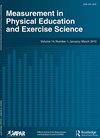使用英语、西班牙语、德语和丹麦语版本的欧洲老年人久坐行为问卷的有效性
IF 1.9
4区 教育学
Q2 EDUCATION & EDUCATIONAL RESEARCH
Measurement in Physical Education and Exercise Science
Pub Date : 2021-05-20
DOI:10.1080/1091367X.2021.1922910
引用次数: 9
摘要
摘要本研究的主要目的是评估久坐行为问卷(SBQ)的标准有效性,该问卷以大腿测量加速度作为标准方法来测量社区老年人的SB。801名参与者(75.6±6.1岁,57.6%女性)提供了有效的基于大腿的加速度计数据(activPAL/Axivity),并完成了SBQ。使用Spearman的Rho系数评估标准的有效性。Bland–Altman图,包括95%的一致性极限和组内相关系数(ICC),用于评估自我报告和设备测量的每日SB时间之间的一致性。使用多元线性回归来检验关联的强度。自我报告和基于设备的SB测量之间存在弱相关性(Rho=0.25,p<.001)。与加速度计相比,SBQ低于估计的每日SB时间。我们的研究结果强调了衡量标准之间的总体弱到中等相关性,每个国家的版本之间存在显著差异。研究人员在使用SBQ来估计老年人的SB时间时应谨慎。本文章由计算机程序翻译,如有差异,请以英文原文为准。
Validity of the Sedentary Behavior Questionnaire in European Older Adults Using English, Spanish, German and Danish Versions
ABSTRACT The main aim of this study was to assess the criterion validity of the Sedentary Behavior Questionnaire (SBQ) to measure SB in community-dwelling older adults using thigh-measured accelerometry as the criterion method. 801 participants (75.6 ± 6.1 years old, 57.6% females) provided valid thigh-based accelerometer data (activPAL/Axivity) and completed the SBQ. Criterion validity was assessed using Spearman’s Rho coefficients. Bland–Altman plots, including 95% limits of agreement and Intraclass Correlation Coefficient (ICC), were used to assess the agreement between self-report and device-measured daily SB time. Strength of the association was examined using multiple linear regression. There was a weak correlation (Rho = 0.25, p < .001) between self-reported and device-based SB measures. The SBQ under-estimated daily SB time compared to accelerometry. Our results highlighted an overall weak-to-moderate correlation between measures, with significant differences between each country’s version. Researchers should be cautious when using the SBQ to provide an estimation of SB time in older adults.
求助全文
通过发布文献求助,成功后即可免费获取论文全文。
去求助
来源期刊

Measurement in Physical Education and Exercise Science
Medicine-Orthopedics and Sports Medicine
CiteScore
4.20
自引率
33.30%
发文量
24
期刊介绍:
The scope of Measurement in Physical Education and Exercise Science (MPEES) covers original measurement research, special issues, and tutorials within six substantive disciplines of physical education and exercise science. Six of the seven sections of MPEES define the substantive disciplines within the purview of the original research to be published in the journal: Exercise Science, Physical Activity, Physical Education Pedagogy, Psychology, Research Methodology and Statistics, and Sport Management and Administration. The seventh section of MPEES, Tutorial and Teacher’s Toolbox, serves to provide an outlet for review and/or didactic manuscripts to be published in the journal. Special issues provide an avenue for a coherent set of manuscripts (e.g., four to five) to collectively focus in-depth on an important and timely measurement-related issue within the scope of MPEES. The primary aim of MPEES is to publish high-impact manuscripts, most of which will focus on original research, that fit within the scope of the journal.
 求助内容:
求助内容: 应助结果提醒方式:
应助结果提醒方式:


